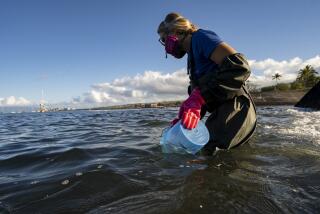Coral reef preservation has a long history
- Share via
Coral reefs have been dying off at alarming rates because of modern human activity, and conservationists struggle to preserve them. Now scientists have found such efforts have a long history.
By the beginning of the 15th century, native Hawaiian islanders were engaging in sustainable practices to preserve their reefs — ushering in 400 years of recovery.
The research, published Monday in the journal PLoS One, shows that sustainable practices go back a long way and that coral reefs may be better able to regenerate than previously thought.
Coral reefs are some of the world’s richest ecosystems, supporting a diverse array of marine life, including reef fish and mollusks. But they’re highly susceptible to modern-day threats such as changing water temperatures, pollution and aggressive fishing practices.
An international team of researchers led by social scientist John Kittinger of Stanford University looked into the islands’ history to see how far back human impacts on the reefs could be traced.
The team looked at 17 archaeological sites around the islands to see what had been tossed over the centuries into community middens, or dumps. They also reviewed ecological studies of the reefs, fisheries data and historical accounts of cultural practices.
When seafaring Polynesians first arrived on the main islands around 1250, they quickly took advantage of the islands’ natural marine bounty — and it showed, Kittinger said. Fish bones in the middens progressively grew smaller — a sign of overfishing, since the largest creatures would have been harvested first.
But by the 1400s, the native populations had begun relying more on raising pigs and dogs and less on fishing. They dug ponds near the sea in which to raise fish rather than harvest the reefs.
Laws and traditions also arose to control fishing. Only community members could fish around the local reef, and sharks — thought to be animal forms of ancestors — were off limits. Only male chiefs could eat turtle meat.
Communities even had land managers, called konohiki, responsible for overseeing natural resources.
Over the next four centuries, fish, monk seals, sea turtles and other mobile creatures recovered by 20%, and reef ecosystems as a whole recovered 10%, the study estimated.
“Primarily, humans are bad for the environment,” Kittinger said. “All we do is muck things up. But in this case, we found that people do have the capacity to manage these ecosystems sustainably — to use coral reefs but not overuse them.”
The careful stewardship fell apart soon after European contact. Fishponds were abandoned, sediment filled reefs, and dynamite fishing was introduced. The Hawaiian island reefs have largely been in decline ever since.
An exception is the northwestern Hawaiian Islands, or Leeward Islands, which have been recovering since the 1950s, largely because there is little human activity in those remote regions, Kittinger said.
Humans may have been damaging coral reefs for centuries, said John Bruno, a marine ecologist at the University of North Carolina at Chapel Hill who was not involved in the study. But, he added, “these reefs are still resilient and able to recover from significant disturbances … certainly, a kernel of good news for reef managers.”







